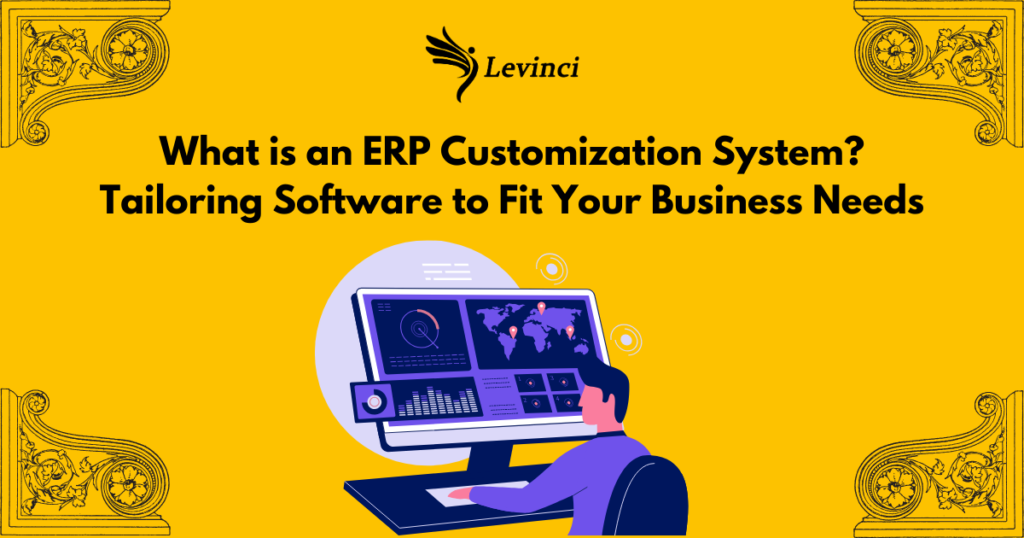In today’s competitive business landscape, having an efficient and well-oiled system is crucial for success. Enter Enterprise Resource Planning (ERP) software, a powerful tool that streamlines various business processes, integrates data and offers a holistic view of your operations. But what happens when the “one-size-fits-all” approach of traditional ERP software doesn’t quite fit your unique needs? That’s where ERP customization systems come in.
What is an ERP system, and why customize it?
imagine a powerful software suite that manages all your crucial business operations, from finance and inventory to human resources and customer relationship management. That’s the magic of Enterprise Resource Planning (ERP) systems. But what happens when the standard features don’t quite match your unique business processes and workflows? That’s where ERP customization steps in, offering a way to tailor the software to your specific needs and unlock its full potential.

An ERP system acts as the central nervous system of your business, integrating various departments and operations into a single platform. It streamlines data flow, automates tasks, and provides real-time insights into your company’s performance. However, off-the-shelf ERP software, while offering a comprehensive set of features, may not always perfectly align with your unique business model. This is where customization comes into play.
Understanding ERP Customization
An ERP customization system allows you to modify an existing ERP solution to align perfectly with your specific workflows and requirements. This is achieved through various methods, including:
- Custom coding: Developers make modifications to the core software code, adding functionalities or features that cater to your specific needs.
- Configuration: Utilizing pre-built options within the software to personalize settings, fields, and workflows to better suit your business processes.
- Integrations: Connecting the ERP system with other software applications you use, ensuring seamless data flow and eliminating manual data entry.
The advantages of ERP Customization
While we’ve already explored several compelling benefits of ERP customization, let’s delve deeper and discover some additional advantages that can significantly enhance your business operations:
1. Increased Compliance and Regulatory Adherence:
Certain industries, like healthcare and finance, have strict regulatory requirements. ERP customization allows you to tailor the system to meet these specific compliance needs. You can integrate compliance modules, automate reporting processes, and ensure data security, reducing the risk of non-compliance and associated penalties.
2. Improved Scalability and Future-Proofing:
As your business grows and evolves, your needs and processes will undoubtedly change. A customized ERP system can adapt and scale alongside your growth. Developers can build in flexibility to accommodate future modifications and integrations, ensuring your system remains relevant and valuable for years to come.

3. Enhanced Decision-Making with Tailored Analytics:
Standard ERP systems might offer generic reporting tools. ERP Customization allows you to create reports and dashboards specific to your key performance indicators (KPIs) and business goals. This deeper level of data analysis empowers you to make informed decisions based on real-time insights tailored to your unique business context.
4. Streamlined Collaboration and Communication:
Effective communication and collaboration are crucial for smooth business operations. Customized workflows within the ERP system can facilitate seamless information sharing and task management across departments. This fosters a more collaborative environment, improves departmental alignment, and ultimately, drives better overall performance.
5. Enhanced Data Security and Control:
With customization, you gain greater control over user access and data security within the ERP system. You can define user permissions based on specific roles and departments, ensuring sensitive data is only accessible to authorized individuals. Additionally, custom integrations can eliminate the need for manual data transfer, mitigating the risk of data breaches and errors.
6. Reduced cost in the long run:
While initial development costs might be higher, ERP can save money in the long run by reducing the need for costly workarounds, integration, and custom coding for generic systems.
By leveraging these additional advantages, ERP customization can transform your software into a powerful engine that drives efficiency, compliance, growth, and ultimately, the success of your business.
Why Consider ERP Customization?

While off-the-shelf ERP software offers a range of benefits, it may not always cater to the unique nuances of your business. Customization offers several advantages:
- Enhanced efficiency: Streamline workflows and automate tasks specific to your operations, leading to increased productivity and cost savings.
- Improved user experience: Tailor the system to your specific needs and user interface preferences, fostering user adoption and improved data accuracy.
- Competitive edge: Gain access to functionalities that set you apart from competitors, allowing you to innovate and optimize your business processes.
Is ERP Customization Right for You?
Before diving into customization, it’s crucial to carefully evaluate your needs and resources. Customization can be a complex and resource-intensive process, requiring:
- Investment: Custom development and ongoing maintenance can be expensive.
- Technical expertise: You may need in-house developers or rely on external consultants to implement and maintain the customized system.
- Careful planning: Thoroughly define your customization goals and ensure they align with your long-term business strategy.
Conclusion
ERP customization systems offer a powerful way to tailor software to your specific needs and unlock its full potential. However, it’s essential to weigh the benefits against the potential challenges before making a decision. By carefully considering your requirements, resources, and long-term goals, you can determine if an ERP customization system is the right fit for your business.
Unleash the Full Potential of Your ERP with Levinci Customization service:

At Levinci, we understand that every business is unique. That’s why we offer comprehensive ERP customization services designed to help you bridge the gap between your off-the-shelf ERP software and your specific needs. Our team of experienced developers and consultants collaborates closely with you to understand your challenges and craft a customized solution that:
- Optimizes workflows: Streamline processes, automate tasks, and eliminate manual data entry for improved efficiency and cost savings.
- Enhances user experience: Tailor the system to your specific needs and user preferences, fostering user adoption and improved data accuracy.
- Empowers innovation: Gain access to functionalities that set you apart from competitors, allowing you to innovate and optimize your business processes.
Ready to unlock the full potential of your ERP system?
Contact Levinci today for a free consultation and discover how our ERP customization services can help your business thrive. We are confident that together, we can tailor your ERP software to perfectly align with your unique needs and drive your business towards success.
Learn more about our ERP customization system: ERP customization service
LEVINCI CO.LTD
Facebook: https://www.facebook.com/LevinciCompany
14/12 Than Nhan Trung, Ward 13, Tan Binh District, Hochiminh city
![]() (+84)(28) 7772 5888
(+84)(28) 7772 5888
![]() ge*****@le**********.com
ge*****@le**********.com
